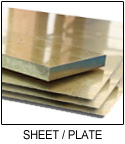Frequently Asked Questions About Brass Alloys
Does brass rust?
No, brass does not rust. In order for an alloy to rust, it has to contain iron - which brass does not.
Does brass do well in applications involving water?
As a general rule, brass is not the best metal for use in applications that require it to be submerged underwater. It loses its zinc component when in water, causing a reduction in the metal’s strength and durability. As a result, the integrity of anything it is used for can be compromised.
Because there are different compositions, some types of brass may be suitable for water applications. Naval brass, for example, contains about 40% zinc and about 1% tin to reduce dezincification. This makes it much more resistant to saltwater.
What is patina?
Patina is a change in the colors of certain metals due to oxidation. When the metal comes into contact with any aggravating environmental agents, such as oxygen or water, this patina or coating will build up along the surface. Patina is often different shades of blue and green.
Some people see brass that has patina and refer to it as rust. But, as stated above, without iron, brass cannot rust. This discoloration is solely due to oxidation. And the patina, in fact, appears to protect the metal from corrosion.
How can you keep brass alloy from corroding?
Keeping a clear coat of sealant over metals like brass can keep it from having contact with natural elements that can cause corrosion. Oxidation occurs when that sealant has worn down over time or has become compromised. As soon as the metal comes in contact with air or water, for instance, it can cause the process to start.
In a matter of minutes, the patina can begin forming over the metal to protect it from corrosion.
If the sealant is ever breached, you can follow proper methods for removing the patina, cleaning, and resealing the metal.
How can I find out which brass is right for my project?
There are many different types of metals - and different compositions for brass alloys. Speaking to a professional is a great way to make sure brass is the best choice for your project. Call the expert team of AtlasBronze at (800) 478-0887.









